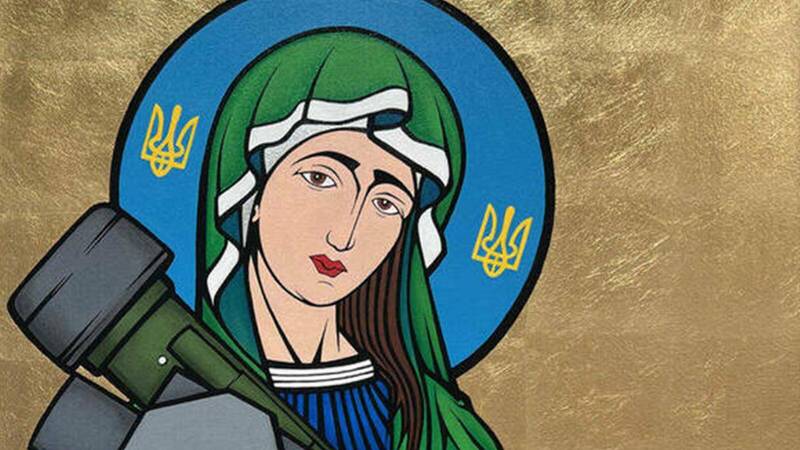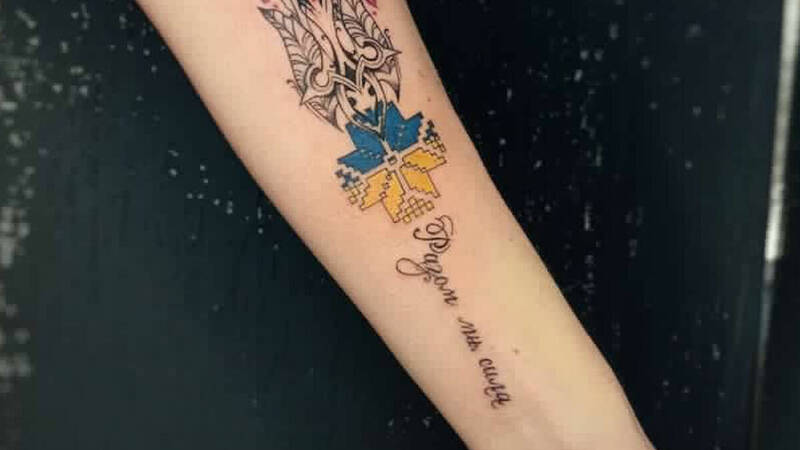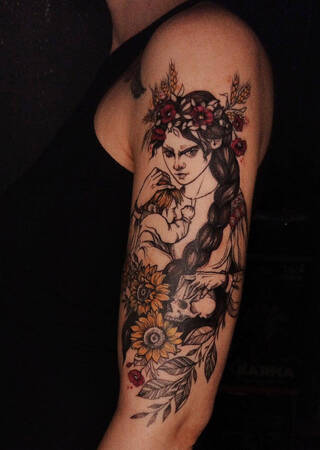
Patriotic Tattoos
Ukrainian Art as Protest and Resilience
Research by Anna Gazewood ’24
Artist: Sandra Sukhetksa
Format: Body art
Placement: Bodies, social media
In the early 21st century, the rise of a modern Ukrainian national identity coincided with the emergence of a patriotic style of Ukrainian tattoos among younger generations. Traditionally, tattoos have been seen as taboo due to religious reasons and their associations with people who have served time in prison. In the context of Ukraine’s resistance to Russian aggression, tattoos that incorporate patriotic and traditional Ukrainian elements are now viewed in a more positive light and as a statement of protest and resilience.
Tattoo artists have taken to social media to share their work that portrays a distinct Ukrainian identity. The two tattoos in this exhibit have been created by Sandra Sukhetksa and were shared on Instagram. The first is a reinterpretation of the Madonna and Child icon. The use of Orthodox Christian iconography depicting figures such as the Madonna and Child, which we see elsewhere in this project, is central to Ukrainian national identity and has become more potent in light of Russian aggression given how religious institutions and practice were suppressed during the Soviet era.
Tattoos by the Ukrainian tattoo artist Sandra Sukhetska (on instagram @sandra_sukhetska). Photos used with permission from the artist.
The mother here, holding a skull, appears angry and determined and is adorned with a vyshyvanka (traditional Ukrainian embroidered shirt) and elements of nature that are popular symbols in Ukrainian culture. The elements of the Madonna’s vinok are all symbolic of Ukrainian national identity and of the context of war: the sunflower, the national flower of Ukraine, has come to represent hope and resistance in the current war; red poppies, associated in many countries with fallen soldiers in both world wars, traditionally represent the deaths of Ukrainian Kozaks (a collection of nationalist, nomadic warriors that were the targets of a massacre by Tsar Peter I in the 18th century); wheat, a plentiful export that has historically been exploited to further Russia’s economic power, has become a symbol of Ukraine’s distinct identity from Russia.
The second tattoo reflects patriotism in each of its four main components. The black and white three-pronged trident is an elaborate depiction of the trident within the Ukrainian coat of arms. This is adorned with poppies which function as symbols of the lives lost in founding and maintaining the Ukrainian nation. The middle ornamentation contains the blue and yellow of the Ukrainian flag while also taking inspiration from an eight-pointed star embroidery pattern utilized in the vyshyvanka. Lastly, the caption translates to “Together we are strong,” showing how tattoos can serve as a means for self-expression as well as a tool for propagating important social ideas such as nationalism.
Since the Russian invasion, many Ukrainian tattoo artists have used their art as a way to raise funds for the war effort. Many have donated all or some of the proceeds raised from creating patriotic tattoos to the Ukrainian army. It is significant that the Russian army reportedly checks Ukrainians entering Russian-occupied zones for patriotic tattoos. While this has caused some Ukrainians to fear retaliation for advertising their patriotism, it demonstrates that the Russian forces view such tattoos pose a threat because they represent the determined spirit of the Ukrainian people who will not concede in the face of danger.
Research by Anna Gazewood ’24
Header image: “St Javelin” by Chris Shaw, acrylic and metal leaf on canvas, completed in March 2022. Image used with permission from Chris Shaw and saintjavelin.com.
Photos and tattoos by Sandra Sukhetksa. Images used with the artist’s permission.
Read the project introduction and background.

